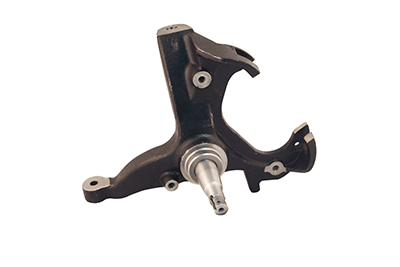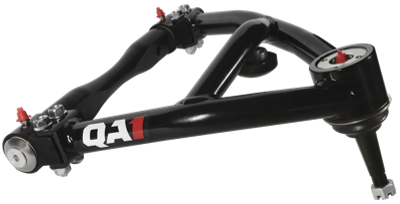Lowering Your Car: QA1 Coil-Over Shocks vs. Drop Spindles
Considerations When Lowering Your Car: QA1 Coil-Over Shocks vs. Drop Spindles
So you've decided to lower your vehicle, but what is the best way to go about achieving the desired look? There are a few different ways to get the car closer to the weeds, but (as always) there is a right way and a wrong way. In this case, there are two proper ways — you can use drop spindles or coil-over shocks, or both! Sometimes it helps to compare the similarities and differences to determine which route is suitable for your application.
What is a Drop Spindle?
A drop spindle merely replaces your stock ride-height spindle with one that relocates the shaft to a higher position (typically 2 to 3 inches) than the original, thus dropping ride height the corresponding amount. The word "drop" can be confusing because the spindle itself is raised, but the name references what it actually does to the car. It is a flat drop — you can't adjust the ride height up, down, left, or right.
Drop spindles don't affect the shock or spring combo, so there won't be any noticeable difference in ride feel. If you like how the car handles, this could be a good way to go, although there could be some clearance issues to consider with tie rods, wheels, or brake calipers. One additional advantage of drop spindles is that it allows for disc brake conversions, a popular upgrade for older vehicles.

How Does an Adjustable Coil-over Differ?
With a coil-over, adjustability is the name of the game. A coil-over shock is precisely as it sounds — a coil spring is over the top of the shock — they function together as one unit while allowing the user to adjust both ride height and quality.
For ride height, the most significant advantage is the ability to tailor the car to your liking, whether you want to maintain traditional stock height, lower it up to two inches, or anywhere in between. If the vehicle leans, it also allows the user to level it side-to-side. A coil-over can be used in conjunction with a drop spindle to get an additional 2 inches of drop for up to 4 inches total.

Ride Quality Differences
When it comes to ride quality, this is where the coil-over gains a significant advantage. A coil-over not only lets you adjust ride height but can also enhance the road quality and performance to suit your needs. Cruising on the interstate, carving corners, and launching at the drag strip require very different conditions.
With a coil-over, you can change the car height and shock stiffness in a matter of minutes. Adjustable valving is a game-changer here. It allows you to fine-tune the shock with the flip of a dial for the situation at hand. If you are cruising on the interstate, a soft setting will do, but you will want a firmer feel if hammering through corners or down the strip.
You still have the same shock and spring with a drop spindle, so you shouldn't feel any improvement over the factory setup. If anything, you may discover a decrease in quality in the steering department from improper tie-rod alignment. Other than lowering the center of gravity, a drop spindle doesn't do much. If you want improved performance, you would have to buy different shocks and springs.
Comparing Installations
If you are already doing some maintenance to the suspension area, such as changing ball joints, bearings, and hubs, the differences here are negligible. However, if you don't need to change any of those parts, the coil-over takes the win for installation ease.
Changing to drop spindles requires removing the brakes, hubs, and bearings, then breaking the ball joints loose from the spindle. Next, you need to transfer everything over to the new drop spindle. If you've gone through that much trouble, it is an excellent time to replace those wear parts such as ball joints, bearings, races, and brake pads.
Coil-over installation is much simpler. Instead of taking your suspension entirely apart, you'll just break the lower control arm loose to swing it down, remove the shock and spring combo, install the new coil-over where the spring was, and replace the control arm.
Cost Comparison
It's true, there is a cost difference, but are you genuinely comparing apples to apples? Depending on the vehicle, a typical coil-over price point is approximately $500 to $550, while drop spindles are in the $200 to $300 range. However, a more apples-to-apples comparison would mean replacing the shocks and springs along with the drop spindle, so adding in the cost of those additional parts makes it is a wash.
If you just want to lower the car and not do anything else, the drop spindle is the cheapest option. However, the key caveat to consider is what you get for the money. A drop spindle is just going to lower the vehicle, but a coil-over lowers the car, improve drivability, and provide adjustability.
Conclusion
Both choices will lower your car, and drop spindles may be all you ever need. But, if you are considering these upgrades, weigh the options based on your future path. If you just want to lower the car and don't see yourself ever replacing any other parts, then drop spindles might be the way to go. But if you are looking for something that ultimately impacts your driving experience with improved performance and drive quality, consider making the first step a coil-over.
The great part is you don't have to settle for one or the other here. Remember, you can use a drop spindle in conjunction with a coil-over to lower the car up to 4 inches. If you are considering both and don't know how low you want to go, start with the coil-over seeing it has height adjustability built into it where a drop spindle offers no options. You can always add a drop spindle later to go lower if you want.
Hopefully, this article gives you enough information to make an informed decision on what is right for your situation. If not, feel free to contact us at (952) 985-5675 or through our website and YouTube channel, where we have plenty more tech tips! Most importantly — #goDRIVEit!

